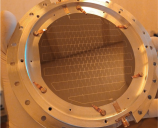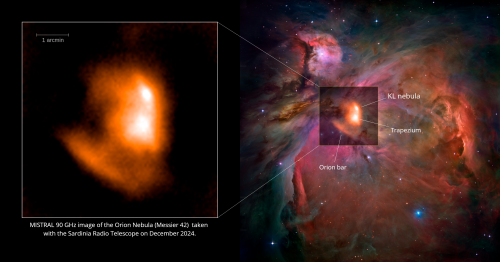
Mistral is the next-generation receiver installed on the Sardinia Radio Telescope (Srt) and built by Sapienza University of Rome for the National Institute for Astrophysics (Inaf) as part of the enhancement of the radio telescope for the study of the universe at high frequencies, funded by a National Operational Program (Pon) project, completed in 2023 and now showing increasingly concrete results.

Mistral stands for “MIllimetric Sardinia radio Telescope Receiver based on Array of Lumped elements kids,” meaning a millimetric wave receiver for the Sardinia Radio Telescope based on a network of kinetic inductance detectors.
It is an innovative receiver in many respects. Radio astronomical receivers are typically “single pixel,” meaning they are sensitive to radiation coming from only one direction, requiring long scans with the telescope to create panoramic images of the sky area of interest. One solution to overcome this limitation is to build “multi-pixel” receivers, sensitive to radiation coming from multiple directions simultaneously. Mistral takes this concept to the extreme. Inside it is housed an ultra-cold core composed of an array of 415 kinetic inductance detectors (Kids) developed in collaboration with Cnr-Ifn in Rome and cooled to just a fraction of a degree above absolute zero, equivalent to -273.15 degrees Celsius. “It is precisely this high number of detectors coupled with a specially developed optical system that makes Mistral an extremely effective and fast tool for wide-field imaging of faint and extended sources,” comments Paolo de Bernardis, scientific coordinator of the receiver for Sapienza University of Rome.
Mistral was installed in May 2023 in the Gregorian focus, located at the center of the large 64-meter diameter parabola of Srt. Immediately afterward, the commissioning of the receiver began: an intense series of technical and observational tests aimed at integrating the receiver into the telescope system.
A team of researchers from Inaf and Sapienza is working side by side with the goal of bringing Mistral to its maximum performance and then offering it to the scientific community for regular observations. “Commissioning is normally a routine step in the installation of new instrumentation,” explains Matteo Murgia, scientific manager of the receiver for Inaf. “However, it becomes a real challenge in the case of a millimetric receiver like Mistral, which requires the telescope’s performance to be pushed to the limit in every aspect.”
“Initially, several obstacles related to the truly exceptional cryogenics of the receiver were faced and overcome, finally achieving the necessary temperature to measure the Kids, which is just 0.2 degrees above absolute zero,” states Elia Battistelli, project manager of the receiver for Sapienza University of Rome. The improvement in the active surface performance of Srt allowed, starting from September 2024, to achieve the adequate sensitivity to calibrate the instrument. It was then possible to proceed with optimizing the alignment between Mistral’s optics and those of Srt.
Image of the Cassiopeia A supernova remnant taken at 90 GHz with the Mistral receiver. Credits: Mistral commissioning team
The commissioning team also worked tirelessly to develop the procedures and software necessary for pointing and focusing. At the same time, Inaf and Sapienza developed the calibration and image composition procedures. At this point, Mistral was finally ready for the “first light” observations of extended radio sources. In succession, three iconic celestial objects were observed: the Orion Nebula, the radio galaxy M87, and the Cassiopeia A supernova remnant. These observations highlighted Mistral’s great versatility and confirmed its ability to produce highly detailed images of celestial objects in very different astrophysical contexts.
“The milestone achieved with the first light images of Srt at 90 GHz,” comments Isabella Pagano, scientific director of Inaf, “marks an important step in expanding the scientific horizons of the radio telescope, demonstrating its ability to successfully operate at the high radio frequencies for which it was designed.” With the “first light” obtained by observing these fascinating cosmic objects, this first phase of technical testing concludes and a no less important phase of scientific validation begins, aimed at verifying Mistral’s performance with increasingly faint sources, to ensure it is ready for the numerous scientific challenges for which it was designed.
Mistral will tackle a wide range of scientific issues, from cosmology and the physics of galaxy clusters to the study of active galactic nuclei, the structure of molecular clouds and their relationship with star formation in nearby galaxies and the Milky Way, to the study of celestial bodies in our Solar System. The commissioning team’s activities therefore continue with the aim of verifying Mistral’s performance in each of these scientific cases and making the receiver available to the scientific community as soon as possible.
THE FIRST IMAGES OF MISTRAL
In December 2024, the instrument was pointed towards the famous Orion Nebula (also known as M42) at the center of the constellation of the same name. Located at a distance of about 1,350 light-years from Earth, M42 is one of the closest active star-forming regions and is characterized by ionized hydrogen excited by a group of massive stars known as the Trapezium. M42 is part of a vast complex of molecular clouds that extends 30 degrees across the sky, while Mistral observed its central part at an angular resolution of 12 arcseconds. In the image, the Orion Bar to the south is clearly visible, marking a sharp boundary between the ionized hydrogen region and the underlying molecular cloud. Emission peaks near the Trapezium stars and the Kleinmann–Low Nebula, a dense star-forming molecular cloud that has hosted a stellar cluster affected by an explosive event in the past, are also noticeable. The emission of M42 visible at 90 GHz is an almost equal mix of radiation produced by ionized hydrogen and that of the cold dust contained in the underlying molecular cloud complex.
In the left panel, the image of the M42 nebula taken at 90 GHz with the Mistral receiver is visible. On the right, an overlay with a wider field image obtained by the Hubble Space Telescope. Credits: Mistral commissioning team; Nasa, Esa, and The Hubble Heritage Team (StscI/Aura)
wide field obtained by the Hubble Space Telescope. Credits: Mistral commissioning team; Nasa, Esa, and The Hubble Heritage Team (StscI/Aura)
In February 2025, Mistral observed, again at the frequency of 90 GHz, the radio galaxy M87, whose active nucleus contains the now-famous supermassive black hole located in the constellation Virgo, the first to have a direct image obtained thanks to the historic observation by the Event Horizon Telescope in 2019. The radio source surrounding M87 has a complex structure, consisting of inner lobes about thirty thousand light-years in size (just over the distance separating us from the center of the Milky Way) surrounded by an outer plasma bubble on a larger scale. These structures are the result of the central black hole’s activity over the past millions of years. In Mistral’s image, the inner radio lobes are visible, the most recent structures still powered by a pair of relativistic radio jets propagating from the central black hole. Observing these structures at such high frequencies provides new and valuable information on the physical mechanisms powering the radio-emitting particles within the source.
Image of the radio source around M87 revealed by Mistral at 90 GHz represented in red tones and contour lines, overlaid on an optical image, in blue tones, of the galaxy. Credits: Mistral commissioning team; Sloan Digital Sky Survey
Finally, in the last session of April 2025, Mistral observed, through two cross scans of about half an hour each, the Cassiopeia A (Cas-A) supernova remnant: one of the most intense radio sources in the sky with an angular size of about 5 arcminutes (about one-sixth of the apparent diameter of the full moon). In the obtained image, the expanding gas shell is visible in its entirety, and thanks to Srt’s angular resolution at these wavelengths, the details and brightness variations of the filamentary structure can be appreciated.